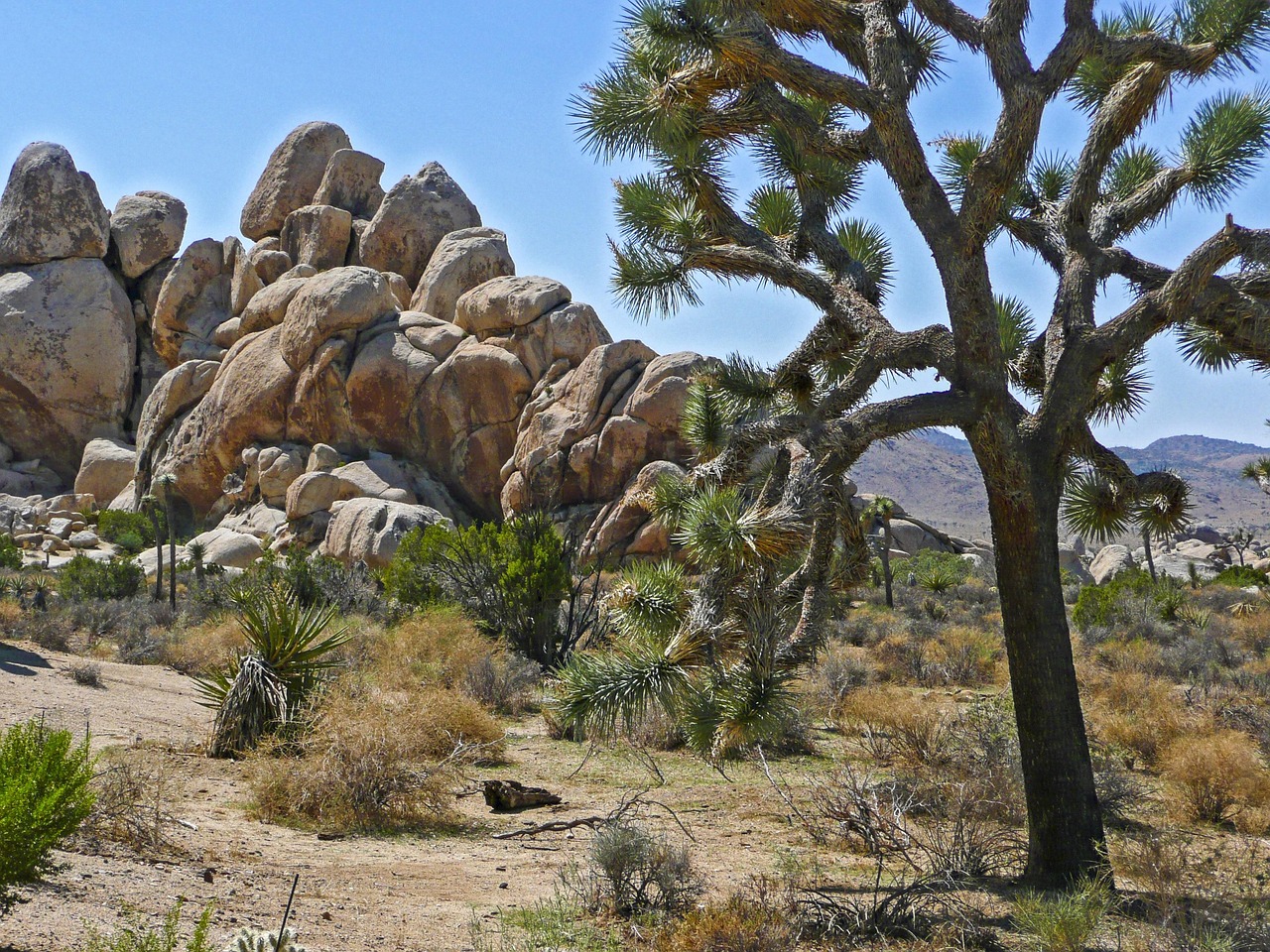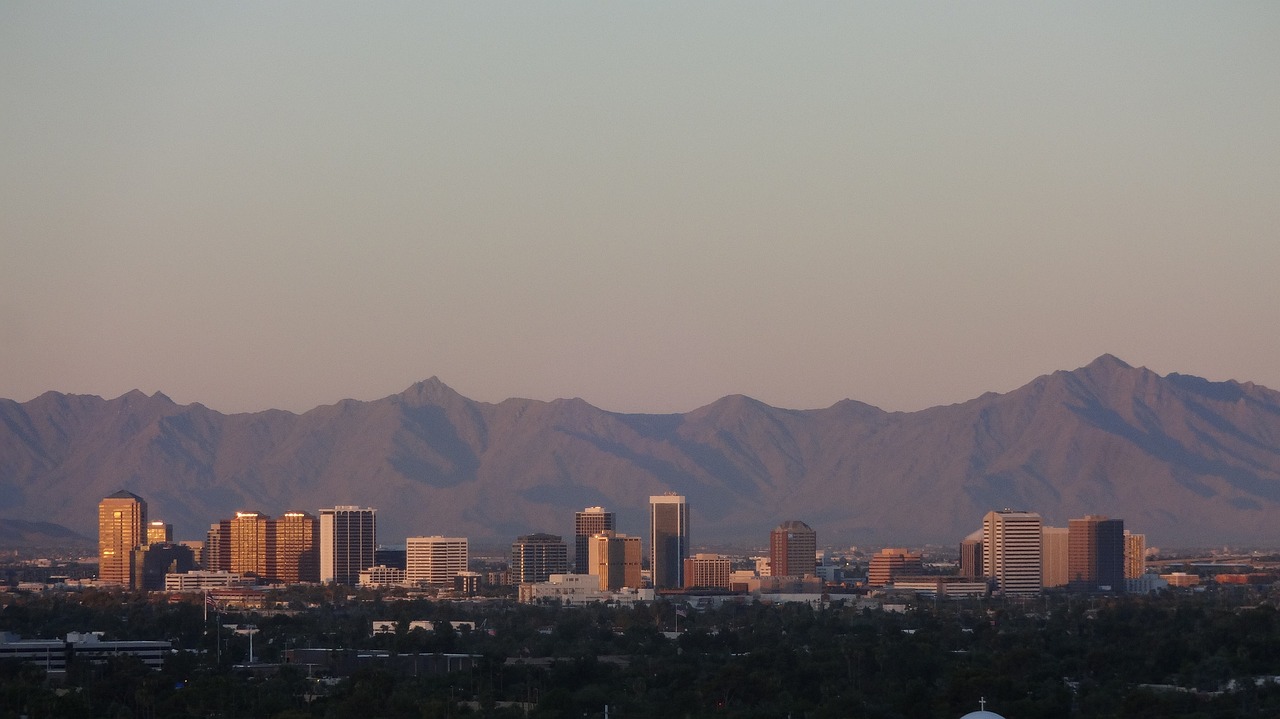
Looking for a unique vacation spot? Joshua Tree National Park is a gem in California. This blog will show you its beauty and how to enjoy it. Get ready for adventure!
Key Takeaways
- Joshua Tree National Park is in California and covers the Mojave and Colorado Deserts. It has unique plants like Joshua Trees and animals like bighorn sheep.
- The park is great for rock climbing, hiking, birdwatching, stargazing, and camping. It has over 8,000 climbing routes and many trails.
- You can see stars clearly at night because there’s not much light pollution. The park also works hard to protect its nature from things like vandalism.
Geography of Joshua Tree National Park

Joshua Tree National Park spans across the Mojave and Colorado Deserts, covering parts of Riverside and San Bernardino Counties in California. The park’s terrain features rugged rock formations, sand dunes, and its iconic Joshua Trees that dot the landscape.
Mojave Desert
The Mojave Desert covers part of Joshua Tree National Park. It’s in California and known for its cool, unique look. This desert has Joshua trees, which stand out against the sky. These trees are tall, green, and look like something from another world.
In this desert, you find big rocks too. People come here to climb them or just see them up close. The weather can change a lot during the day. It’s cooler in the morning but can get very hot by noon.
So, many visitors plan their trips around this to have fun and stay safe.
Colorado Desert
Covering the eastern part of Joshua Tree National Park, the Colorado Desert is a sight to see. It sits below 3,000 feet in elevation. This desert has its own unique landscape. You won’t find Joshua trees here.
Instead, it’s home to ocotillo plants and cholla cactus gardens that catch the eye.
Visitors often get surprised by how different it looks from the Mojave Desert section of the park. The Colorado Desert features vast areas of creosote bush flats and rugged mountains in the distance.
It’s a key area for spotting wildlife like bighorn sheep and various bird species that thrive in this environment.
Unique Natural Features
Joshua Tree National Park is home to the iconic Joshua trees, striking rock formations, and hidden valleys. These unique natural features provide a breathtaking backdrop for outdoor adventures and opportunities for photographers to capture stunning landscapes.
Joshua Trees
Joshua Trees stand tall in the Mojave Desert, a key part of Joshua Tree National Park. These trees are unique to this area. They can live for hundreds of years. Some are over 40 feet tall.
They grow slowly, about 2.3 inches per year.
People come from all over to see these trees. They have a special shape that looks like something from another world. The park gets its name from them. Visitors love taking pictures with the Joshua Trees because they are very different from other plants.
Rugged Rock Formations
After appreciating the unique Joshua Trees, visitors can explore the rugged rock formations that define the park’s landscape. These formations are a result of millions of years of geologic processes, including uplifts and erosion.
As a result, numerous towering boulders and intricate mazes of rocks create an awe-inspiring environment for hikers and photographers alike. Some iconic rock formations include Skull Rock and Arch Rock, offering remarkable settings for capturing memorable photographs against the desert backdrop.
The diverse shapes and sizes of these rocks also make Joshua Tree National Park a renowned destination for rock climbers from around the world. Additionally, hidden amidst these formations is Hidden Valley—a picturesque enclosure formed by colossal walls with only one narrow entrance—making it a tranquil spot for picnics or simply marveling at nature’s artwork in this extraordinary park.
Hidden Valley
Hidden Valley is a geologic wonder inside Joshua Tree National Park. This enclosed valley is surrounded by tall rock formations that create a secluded and peaceful space for visitors to explore.
The valley’s unique landscape offers opportunities for short hikes, rock climbing, and even picnicking in the shaded areas provided by the towering rocks.
Visitors are drawn to Hidden Valley for its breathtaking scenery and mild climate, making it an ideal spot for wildlife observation and photography. The area is also known as an excellent location to appreciate the beautiful Joshua Trees that dot the landscape, adding to its allure as a must-see destination within the park.
Recreational Activities
Explore rugged rock formations and hidden valleys, offering a thrilling terrain for hiking and rock climbing adventures. Set up camp, watch for diverse bird species, and gaze at mesmerizing star-filled skies in this vast desert landscape.
Hiking Trails
Explore the breathtaking beauty of Joshua Tree National Park through its extensive network of hiking trails. With over 191 miles of trails, visitors can choose from easy strolls to challenging hikes offering panoramic views of the desert landscape and unique rock formations.
The park’s diverse terrain provides a range of experiences for all levels of hikers, from meandering paths through cactus gardens to rugged climbs with rewarding vistas. Be prepared to encounter distinctive flora and fauna along the way, including the iconic Joshua trees and perhaps even catch sight of bighorn sheep among the rocky outcrops.
Don’t forget to bring plenty of water and sunscreen as you venture onto these scenic routes; also ensure that you stick to designated trails to preserve both natural habitats and your own safety.
For those seeking a more immersive adventure, consider exploring one or more sections of the renowned California Riding & Hiking Trail—a 37-mile path traversing varied landscapes ranging from lush oases to sunbaked valleys—providing an unparalleled opportunity to appreciate this remarkable national treasure.
Rock Climbing
The rocky terrains of Joshua Tree National Park offer thrilling opportunities for rock climbing. With over 8,000 established routes, it’s a paradise for climbers of all levels. The park’s unique granite formations provide an exciting challenge and stunning views for climbers.
You’ll find diverse climbing options from bouldering to traditional multi-pitch climbs, making it a prime destination for enthusiasts. The best time to enjoy this activity is in the cooler months when the friction on the rocks is at its peak.
Whether you’re a beginner or an experienced climber, Joshua Tree has something for everyone.
As one of the premier rock climbing destinations globally, Joshua Tree accommodates both novices and seasoned climbers with its array of challenging routes and iconic landscapes that make every ascent an unforgettable experience.
Camping
After a thrilling day of rock climbing, camping in Joshua Tree National Park is an adventure you won’t want to miss. With nine established campgrounds, offering over 500 campsites, there’s something for every type of camper.
Whether you prefer the convenience of modern amenities or crave a more primitive experience, the park has got you covered. From stargazing at night to waking up amidst beautiful desert landscapes, camping in Joshua Tree is an unparalleled way to connect with nature.
The campgrounds are equipped with picnic tables, fire grates, and pit toilets while some also offer water and RV dump stations. It’s essential to plan ahead as many sites are first-come-first-serve during peak seasons.
Keep in mind that Black Rock and Cottonwood campgrounds take reservations online but typically fill up quickly due to their popularity. In addition, backcountry camping is allowed throughout much of the park with a few regulations for your safety and preservation of this remarkable landscape.
Birdwatching
Visitors to Joshua Tree National Park can relish in the diverse birdwatching opportunities in the area. With over 250 bird species recorded, including the iconic roadrunner and Gambel’s quail, it’s a haven for bird enthusiasts.
The park’s distinct habitats like desert washes and cactus gardens attract various bird species, making it an excellent spot for observing and photographing these feathered residents.
Furthermore, during spring and fall migrations, numerous birds pass through the park on their journey north or south, providing fantastic opportunities to witness large flocks of migratory birds.
Birdwatchers should keep an eye out for annual events organized by the park that celebrate this natural spectacle. Whether you’re a seasoned birder or just beginning your avian adventures, Joshua Tree National Park offers unique experiences for all levels of interest in birdwatching.
Stargazing and Astronomy
In Joshua Tree National Park, the night sky is a breathtaking sight. With minimal light pollution, it’s one of the best places for stargazing. The park offers astronomy programs and guided stargazing events to help visitors fully appreciate the celestial wonders above.
During peak meteor shower dates, such as the Perseids in August, visitors can witness shooting stars in abundance.
The clear desert skies create an ideal environment for observing planets like Jupiter and Saturn or distant galaxies and nebulae through telescopes. In fact, Joshua Tree National Park is recognized by the International Dark-Sky Association for its exceptional starry nights.
Visitors can also enjoy self-guided stargazing adventures at their own pace throughout various points within the park, providing a unique way to experience nature after dark without infringing on wildlife habitats or disrupting other visitors’ experiences.
Flora and Fauna
Joshua Tree National Park is home to a diverse range of plant and animal species, including native wildlife and some invasive species. The park’s unique desert ecosystem provides a habitat for creatures like bighorn sheep, pinyon pine, and an array of cactus gardens.
Native Wildlife
Joshua Tree National Park is home to a diverse range of native wildlife, including bighorn sheep, desert tortoises, and jackrabbits. The park’s unique desert ecosystem supports these fascinating creatures.
Birdwatchers can spot over 250 species of birds, from golden eagles to roadrunners. Keep an eye out for reptiles like the western diamondback rattlesnake sunning on the rocks or the elusive chuckwalla blending into the terrain.
Take your time to admire these remarkable animals while exploring the park’s hiking trails and rugged landscapes.
Invasive Species
While Joshua Tree National Park is known for its unique natural features and diverse wildlife, it also faces challenges from invasive species. These are non-native plants or animals that disrupt the park’s ecosystem.
Some of the invasive plant species in the park include Sahara mustard, which outcompetes native plants, and tamarisk, a tree that consumes large amounts of water, threatening the survival of native vegetation.
Invasive animal species such as feral pigs and red-eared slider turtles also pose a threat to the park’s delicate balance by competing with native wildlife for resources and habitat.
Park rangers and conservationists work tirelessly to control these invasive species through various methods such as mechanical removal, herbicide treatments, and biological controls to protect the natural habitat.
Visitors can support these efforts by not bringing in outside firewood or seeds that could introduce new invasive species to this unique environment. By being mindful of their movements within the park and adhering to guidelines set forth by the National Park Service, visitors play an essential role in preserving Joshua Tree’s delicate ecosystem for future generations to enjoy.
Climate and Weather
The park experiences extreme temperature variations due to its desert climate. Summers are scorching, often reaching over 100°F, while winters can be chilly with occasional frost and snow at higher elevations.
Seasonal Variations
Joshua Tree National Park experiences extreme temperature variations. Summers are scorching hot, with temperatures often exceeding 100°F, while winters can be chilly, dropping to around 60°F during the day and near freezing at night.
Spring and fall offer mild and pleasant weather, making them ideal for outdoor activities like hiking and camping without extreme heat or cold affecting your enjoyment.
The park sees most visitors in spring when wildflowers bloom profusely due to occasional rainfall. Fall is also popular as temperatures cool down after the summer heat. Winter is less crowded but offers clear skies for stargazing.
Summer tends to be the quietest season due to intense heat levels that challenge outdoor excursions.
Let’s now delve into the best times to visit this remarkable national park.- Geography of Joshua Tree National Park
Best Times to Visit
The best time to visit Joshua Tree National Park is in the spring and fall when the weather is milder, and wildflowers are in bloom. During these seasons, temperatures are comfortable for hiking and exploring the park’s unique landscapes, with average highs ranging from 70°F to 90°F.
The winter months can also be pleasant during the day but colder at night, making it ideal for stargazing due to clearer skies. However, summer brings scorching heat with average highs exceeding 100°F, so it’s best to avoid visiting during this time.
Visitors should plan their trip around mild temperatures to fully enjoy hiking trails, rock climbing adventures, birdwatching opportunities, and mesmerizing stargazing experiences that Joshua Tree has to offer without extreme weather conditions interrupting their activities.
Moving onto Conservation and Preservation…
Conservation and Preservation
Joshua Tree National Park is dedicated to protecting its unique landscapes and wildlife, with ongoing efforts from the National Park Service. However, challenges like vandalism pose a threat to this preservation mission.
Protection Efforts
The Joshua Tree National Park is safeguarded by the National Park Service to preserve its unique natural features, diverse wildlife, and delicate desert ecosystems. The park rangers work tirelessly to protect the area from vandalism, ensuring that visitors can enjoy the park’s beauty for generations to come.
Efforts such as educational programs also aim to raise awareness about the importance of preserving this stunning landscape.
In addition to ranger patrolling, innovative technologies like surveillance cameras are installed in sensitive areas of the park. These efforts help prevent illegal activities and ensure that both visitors and wildlife can continue to thrive within this protected area.
As a result, you can explore the wonders of Joshua Tree National Park with confidence, knowing that its preservation is a top priority.
Moving forward in our exploration of this beautiful national treasure…
Challenges Like Vandalism
Vandalism is a problem at Joshua Tree National Park. Some visitors deface rocks and trees with graffiti or carvings. This damages the park’s natural beauty and harms the delicate desert ecosystem.
The National Park Service has had to spend time and money cleaning up and repairing these acts of vandalism, taking resources away from other important conservation efforts.
To protect this unique environment, it’s crucial for visitors to respect the park’s rules and regulations. Keep an eye out for any signs of vandalism and report it immediately to park rangers.
By working together, we can help preserve Joshua Tree National Park for future generations to enjoy its stunning landscapes and diverse wildlife.
Conclusion
Discover the unique beauty of Joshua Tree National Park. Explore its desert landscapes through hikes and rock climbing adventures. Witness the rugged rock formations, Joshua Trees, and diverse wildlife.
Capture stunning photographs of this protected area’s natural wonders. Visit at different times to experience its changing climate and weather patterns. Immerse yourself in conservation efforts to preserve this extraordinary national park.
FAQs
1. What is Joshua Tree National Park?
Joshua Tree National Park is a beautiful place in California, known for its unique trees, stunning rock formations, and diverse wildlife. It’s a great spot for hiking, climbing, and enjoying nature.
2. How do I get to Joshua Tree National Park?
To reach Joshua Tree National Park, you can drive from nearby cities like Los Angeles or Palm Springs. The park has several entrances with clear signs that guide you along the way.
3. What activities can I do at the park?
At Joshua Tree National Park, visitors can hike on various trails, climb rocks if they’re adventurous, camp under the stars at night, and take photos of amazing landscapes and plants like the iconic Joshua trees.
4. When is the best time to visit?
The best time to visit Joshua Tree National Park is during spring or fall when temperatures are mild and pleasant. Summer can be very hot while winter might bring cooler weather but offers a different beauty in the desert landscape.







Leave a Reply